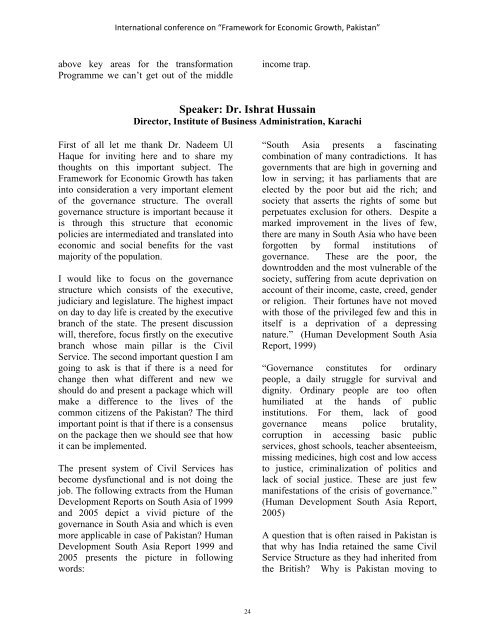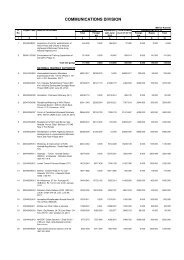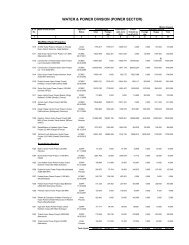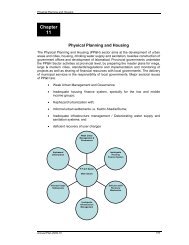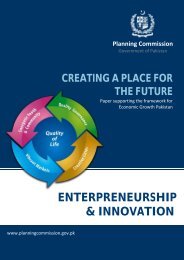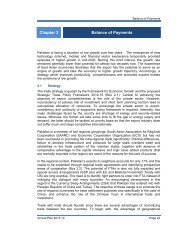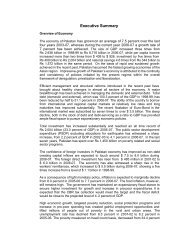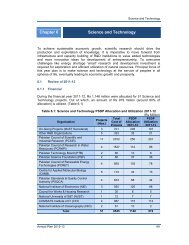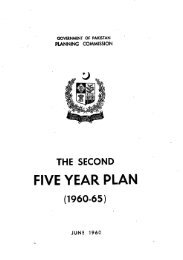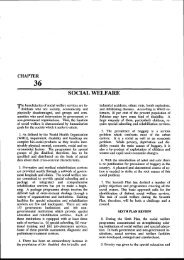Framework for Economic Growth, Pakistan - Planning Commission
Framework for Economic Growth, Pakistan - Planning Commission
Framework for Economic Growth, Pakistan - Planning Commission
You also want an ePaper? Increase the reach of your titles
YUMPU automatically turns print PDFs into web optimized ePapers that Google loves.
International conference on “<strong>Framework</strong> <strong>for</strong> <strong>Economic</strong> <strong>Growth</strong>, <strong>Pakistan</strong>”above key areas <strong>for</strong> the trans<strong>for</strong>mationProgramme we can’t get out of the middleincome trap.Speaker: Dr. Ishrat HussainDirector, Institute of Business Administration, KarachiFirst of all let me thank Dr. Nadeem UlHaque <strong>for</strong> inviting here and to share mythoughts on this important subject. The<strong>Framework</strong> <strong>for</strong> <strong>Economic</strong> <strong>Growth</strong> has takeninto consideration a very important elementof the governance structure. The overallgovernance structure is important because itis through this structure that economicpolicies are intermediated and translated intoeconomic and social benefits <strong>for</strong> the vastmajority of the population.I would like to focus on the governancestructure which consists of the executive,judiciary and legislature. The highest impacton day to day life is created by the executivebranch of the state. The present discussionwill, there<strong>for</strong>e, focus firstly on the executivebranch whose main pillar is the CivilService. The second important question I amgoing to ask is that if there is a need <strong>for</strong>change then what different and new weshould do and present a package which willmake a difference to the lives of thecommon citizens of the <strong>Pakistan</strong>? The thirdimportant point is that if there is a consensuson the package then we should see that howit can be implemented.The present system of Civil Services hasbecome dysfunctional and is not doing thejob. The following extracts from the HumanDevelopment Reports on South Asia of 1999and 2005 depict a vivid picture of thegovernance in South Asia and which is evenmore applicable in case of <strong>Pakistan</strong>? HumanDevelopment South Asia Report 1999 and2005 presents the picture in followingwords:“South Asia presents a fascinatingcombination of many contradictions. It hasgovernments that are high in governing andlow in serving; it has parliaments that areelected by the poor but aid the rich; andsociety that asserts the rights of some butperpetuates exclusion <strong>for</strong> others. Despite amarked improvement in the lives of few,there are many in South Asia who have been<strong>for</strong>gotten by <strong>for</strong>mal institutions ofgovernance. These are the poor, thedowntrodden and the most vulnerable of thesociety, suffering from acute deprivation onaccount of their income, caste, creed, genderor religion. Their <strong>for</strong>tunes have not movedwith those of the privileged few and this initself is a deprivation of a depressingnature.” (Human Development South AsiaReport, 1999)“Governance constitutes <strong>for</strong> ordinarypeople, a daily struggle <strong>for</strong> survival anddignity. Ordinary people are too oftenhumiliated at the hands of publicinstitutions. For them, lack of goodgovernance means police brutality,corruption in accessing basic publicservices, ghost schools, teacher absenteeism,missing medicines, high cost and low accessto justice, criminalization of politics andlack of social justice. These are just fewmanifestations of the crisis of governance.”(Human Development South Asia Report,2005)A question that is often raised in <strong>Pakistan</strong> isthat why has India retained the same CivilService Structure as they had inherited fromthe British? Why is <strong>Pakistan</strong> moving to24


